Strategic Human Resource Management Analysis for Travelodge Hotels
VerifiedAdded on 2023/01/12
|14
|5098
|28
Report
AI Summary
This report provides a comprehensive analysis of strategic human resource management (HRM) practices within Travelodge Hotels Ltd. It begins by exploring current trends and developments in HR strategy, emphasizing the impact of globalization, workplace diversity, changing skill requirements, and the continuous focus on improving customer experience. The report then delves into the analysis of internal and external factors influencing HR strategies, including political, economic, social, and technological factors, as well as organizational policies, culture, conflicts, and structure. It critically evaluates the influence of these factors and examines relevant HRM theories and models, such as unrealistic theory, contingency theory, flexible working environments, performance management, personnel management theory, and strategic HRM concepts. The report also evaluates the effectiveness of these theories in relation to the organization and discusses change management models that support HR strategies, including monitoring and measuring HR outcomes. The report concludes with an evaluation of effective HRM and development practices that can support sustainable performance within Travelodge, offering valuable insights into optimizing human resource management for improved organizational outcomes.
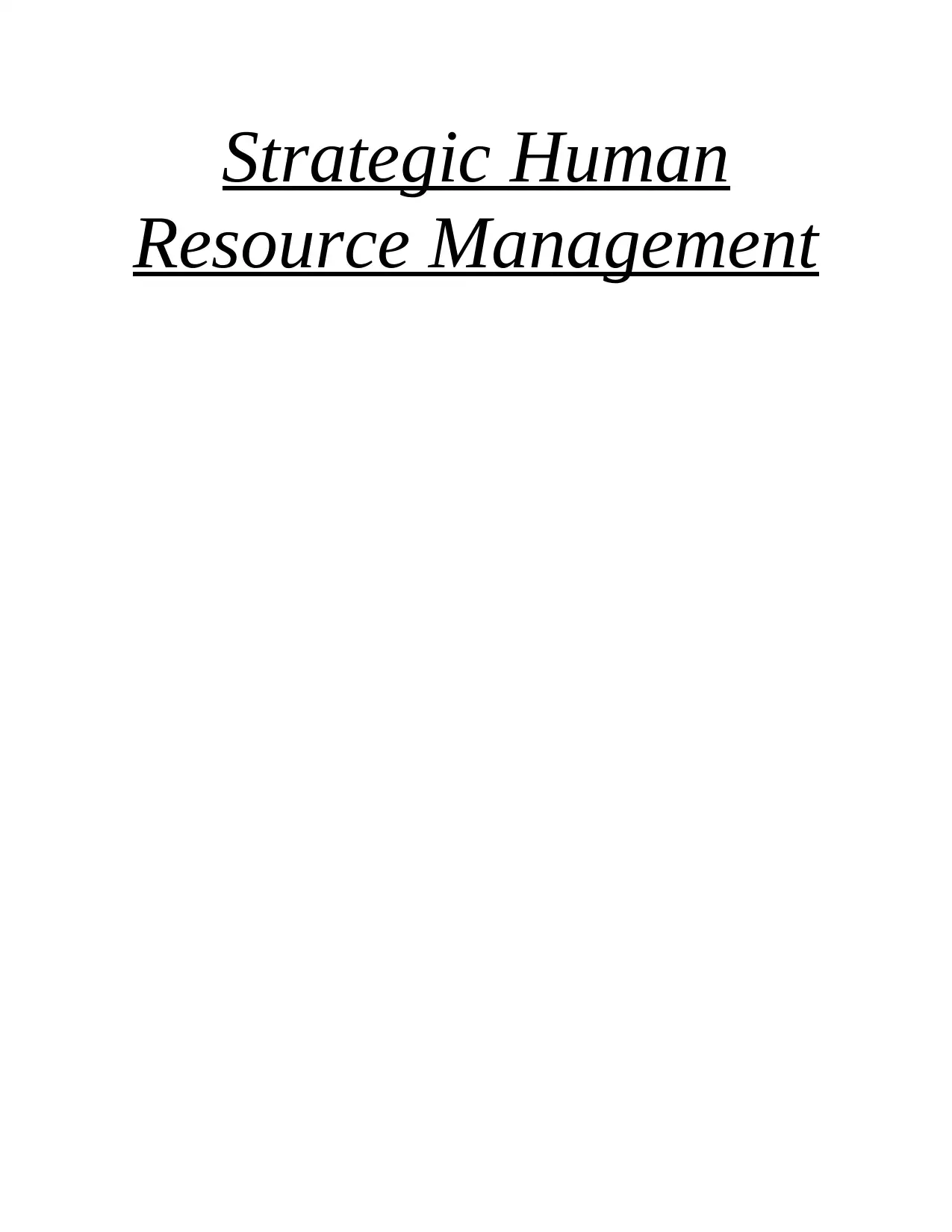
Strategic Human
Resource Management
Resource Management
Paraphrase This Document
Need a fresh take? Get an instant paraphrase of this document with our AI Paraphraser
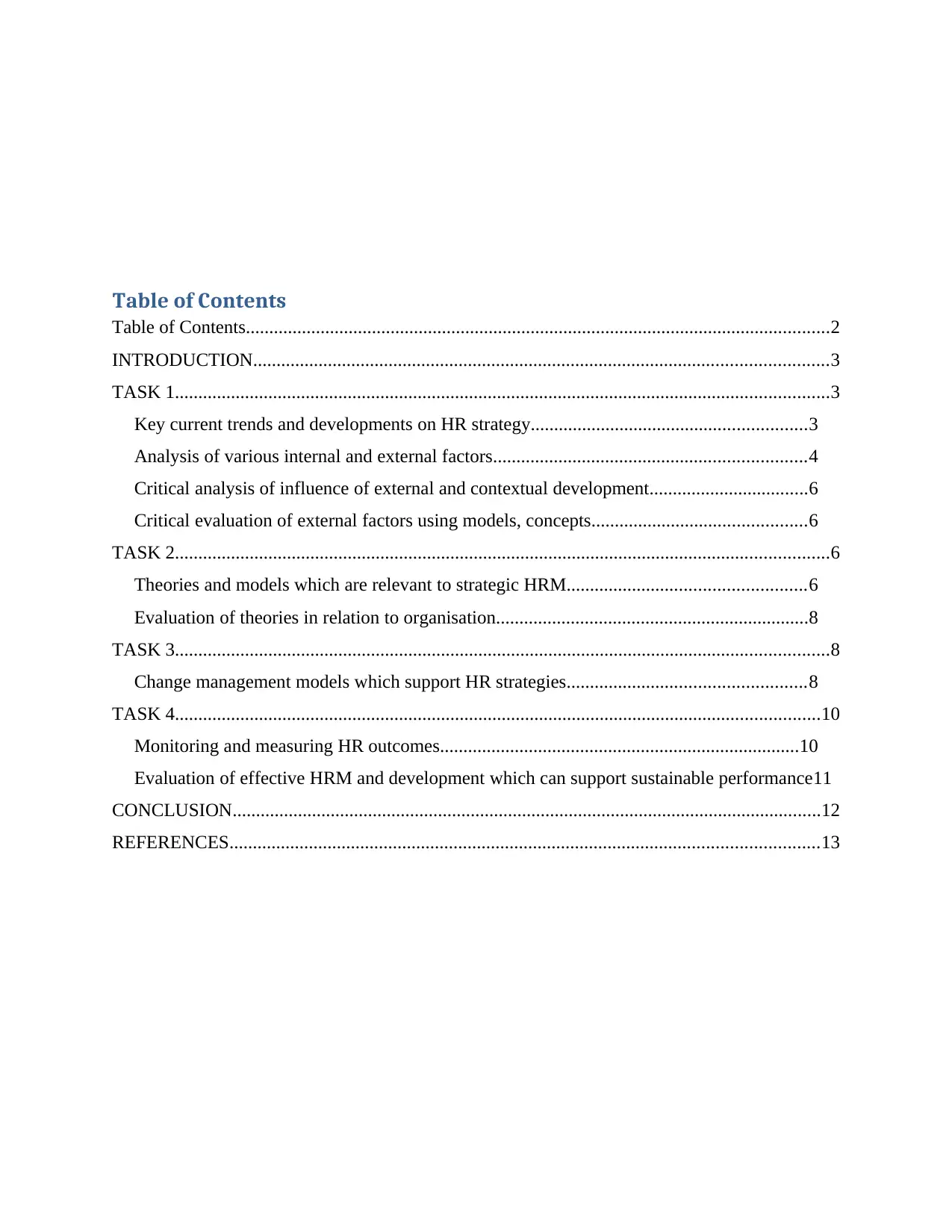
Table of Contents
Table of Contents.............................................................................................................................2
INTRODUCTION...........................................................................................................................3
TASK 1............................................................................................................................................3
Key current trends and developments on HR strategy...........................................................3
Analysis of various internal and external factors...................................................................4
Critical analysis of influence of external and contextual development..................................6
Critical evaluation of external factors using models, concepts..............................................6
TASK 2............................................................................................................................................6
Theories and models which are relevant to strategic HRM...................................................6
Evaluation of theories in relation to organisation...................................................................8
TASK 3............................................................................................................................................8
Change management models which support HR strategies...................................................8
TASK 4..........................................................................................................................................10
Monitoring and measuring HR outcomes.............................................................................10
Evaluation of effective HRM and development which can support sustainable performance11
CONCLUSION..............................................................................................................................12
REFERENCES..............................................................................................................................13
Table of Contents.............................................................................................................................2
INTRODUCTION...........................................................................................................................3
TASK 1............................................................................................................................................3
Key current trends and developments on HR strategy...........................................................3
Analysis of various internal and external factors...................................................................4
Critical analysis of influence of external and contextual development..................................6
Critical evaluation of external factors using models, concepts..............................................6
TASK 2............................................................................................................................................6
Theories and models which are relevant to strategic HRM...................................................6
Evaluation of theories in relation to organisation...................................................................8
TASK 3............................................................................................................................................8
Change management models which support HR strategies...................................................8
TASK 4..........................................................................................................................................10
Monitoring and measuring HR outcomes.............................................................................10
Evaluation of effective HRM and development which can support sustainable performance11
CONCLUSION..............................................................................................................................12
REFERENCES..............................................................................................................................13
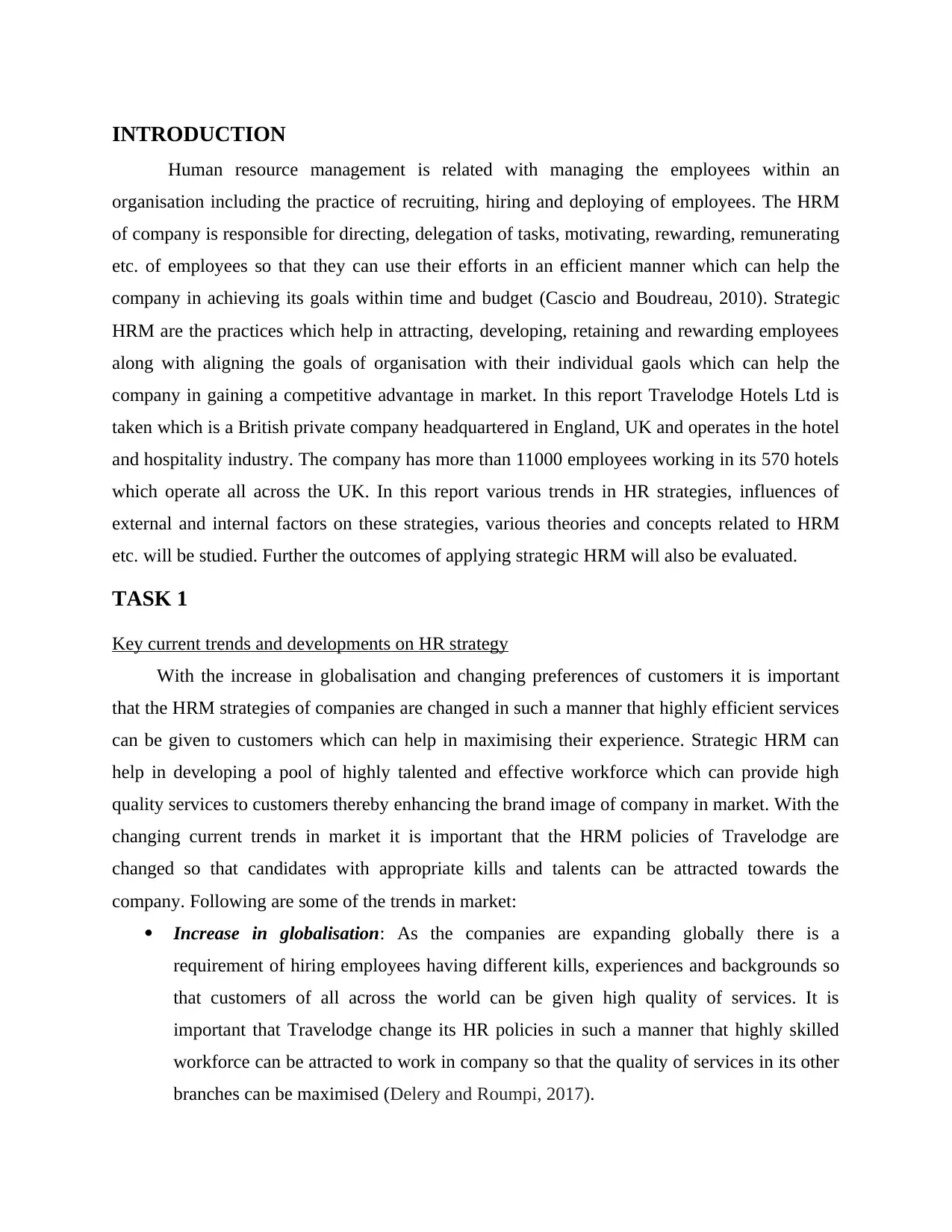
INTRODUCTION
Human resource management is related with managing the employees within an
organisation including the practice of recruiting, hiring and deploying of employees. The HRM
of company is responsible for directing, delegation of tasks, motivating, rewarding, remunerating
etc. of employees so that they can use their efforts in an efficient manner which can help the
company in achieving its goals within time and budget (Cascio and Boudreau, 2010). Strategic
HRM are the practices which help in attracting, developing, retaining and rewarding employees
along with aligning the goals of organisation with their individual gaols which can help the
company in gaining a competitive advantage in market. In this report Travelodge Hotels Ltd is
taken which is a British private company headquartered in England, UK and operates in the hotel
and hospitality industry. The company has more than 11000 employees working in its 570 hotels
which operate all across the UK. In this report various trends in HR strategies, influences of
external and internal factors on these strategies, various theories and concepts related to HRM
etc. will be studied. Further the outcomes of applying strategic HRM will also be evaluated.
TASK 1
Key current trends and developments on HR strategy
With the increase in globalisation and changing preferences of customers it is important
that the HRM strategies of companies are changed in such a manner that highly efficient services
can be given to customers which can help in maximising their experience. Strategic HRM can
help in developing a pool of highly talented and effective workforce which can provide high
quality services to customers thereby enhancing the brand image of company in market. With the
changing current trends in market it is important that the HRM policies of Travelodge are
changed so that candidates with appropriate kills and talents can be attracted towards the
company. Following are some of the trends in market:
Increase in globalisation: As the companies are expanding globally there is a
requirement of hiring employees having different kills, experiences and backgrounds so
that customers of all across the world can be given high quality of services. It is
important that Travelodge change its HR policies in such a manner that highly skilled
workforce can be attracted to work in company so that the quality of services in its other
branches can be maximised (Delery and Roumpi, 2017).
Human resource management is related with managing the employees within an
organisation including the practice of recruiting, hiring and deploying of employees. The HRM
of company is responsible for directing, delegation of tasks, motivating, rewarding, remunerating
etc. of employees so that they can use their efforts in an efficient manner which can help the
company in achieving its goals within time and budget (Cascio and Boudreau, 2010). Strategic
HRM are the practices which help in attracting, developing, retaining and rewarding employees
along with aligning the goals of organisation with their individual gaols which can help the
company in gaining a competitive advantage in market. In this report Travelodge Hotels Ltd is
taken which is a British private company headquartered in England, UK and operates in the hotel
and hospitality industry. The company has more than 11000 employees working in its 570 hotels
which operate all across the UK. In this report various trends in HR strategies, influences of
external and internal factors on these strategies, various theories and concepts related to HRM
etc. will be studied. Further the outcomes of applying strategic HRM will also be evaluated.
TASK 1
Key current trends and developments on HR strategy
With the increase in globalisation and changing preferences of customers it is important
that the HRM strategies of companies are changed in such a manner that highly efficient services
can be given to customers which can help in maximising their experience. Strategic HRM can
help in developing a pool of highly talented and effective workforce which can provide high
quality services to customers thereby enhancing the brand image of company in market. With the
changing current trends in market it is important that the HRM policies of Travelodge are
changed so that candidates with appropriate kills and talents can be attracted towards the
company. Following are some of the trends in market:
Increase in globalisation: As the companies are expanding globally there is a
requirement of hiring employees having different kills, experiences and backgrounds so
that customers of all across the world can be given high quality of services. It is
important that Travelodge change its HR policies in such a manner that highly skilled
workforce can be attracted to work in company so that the quality of services in its other
branches can be maximised (Delery and Roumpi, 2017).
⊘ This is a preview!⊘
Do you want full access?
Subscribe today to unlock all pages.

Trusted by 1+ million students worldwide

Workplace diversity: Having a diverse workforce culture is also increasing in companies
which means that employees belonging to different nations, religions, culture, age, caste,
sex etc. work together in companies. This means that HR strategy in Travelodge must be
changed so that the efforts of diverse workforce can be integrated which can be done by
encouraging employee engagement, performance base appraisal etc.
Changing requirement of skills: As the requirements and preferences of customers keep
on changing it increase the need for HR strategies to change so that the required skills
can be developed in employees which can help them in meeting the requirements of
customers. Training and development programmes in Travelodge can help in developing
the required skills in employees so that customer satisfaction can be maximised
(Ganopoulos and et. al., 2013).
Continuous focus on improving customer experience: Maximisation of customer
satisfaction is the main aim of all organisations which means that the strategies of
company must be changed so that continuous improvement can be achieved in customer
experience. It is important that Travelodge focus on improving customer experience by
developing employee skills and encouraging better work performance of customers.
All the above trends thus affect Travelodge strategies of HR which can help in making the
workforce more efficient and effective in providing efficient services to customers (Reiche and
Oddou, 2016).
Analysis of various internal and external factors
The internal and external factors of business environment which affect businesses also
affect the HR strategies which determine the way in which the work within an organisation is
managed and completed by the workers.
External factors:
Political: These are the governmental rules and regulations which affect businesses like
trade tariffs, taxation etc. These also affect the HR strategies as the salaries, employee
regulation, recruitment strategies etc. so that the employees can be treated in accordance
with government laws and can be given a legal and fair treatment. Travelodge must
follow all the rules and regulations of government so that trust of employees in company
can increase (Lim and et. al., 2017).
which means that employees belonging to different nations, religions, culture, age, caste,
sex etc. work together in companies. This means that HR strategy in Travelodge must be
changed so that the efforts of diverse workforce can be integrated which can be done by
encouraging employee engagement, performance base appraisal etc.
Changing requirement of skills: As the requirements and preferences of customers keep
on changing it increase the need for HR strategies to change so that the required skills
can be developed in employees which can help them in meeting the requirements of
customers. Training and development programmes in Travelodge can help in developing
the required skills in employees so that customer satisfaction can be maximised
(Ganopoulos and et. al., 2013).
Continuous focus on improving customer experience: Maximisation of customer
satisfaction is the main aim of all organisations which means that the strategies of
company must be changed so that continuous improvement can be achieved in customer
experience. It is important that Travelodge focus on improving customer experience by
developing employee skills and encouraging better work performance of customers.
All the above trends thus affect Travelodge strategies of HR which can help in making the
workforce more efficient and effective in providing efficient services to customers (Reiche and
Oddou, 2016).
Analysis of various internal and external factors
The internal and external factors of business environment which affect businesses also
affect the HR strategies which determine the way in which the work within an organisation is
managed and completed by the workers.
External factors:
Political: These are the governmental rules and regulations which affect businesses like
trade tariffs, taxation etc. These also affect the HR strategies as the salaries, employee
regulation, recruitment strategies etc. so that the employees can be treated in accordance
with government laws and can be given a legal and fair treatment. Travelodge must
follow all the rules and regulations of government so that trust of employees in company
can increase (Lim and et. al., 2017).
Paraphrase This Document
Need a fresh take? Get an instant paraphrase of this document with our AI Paraphraser
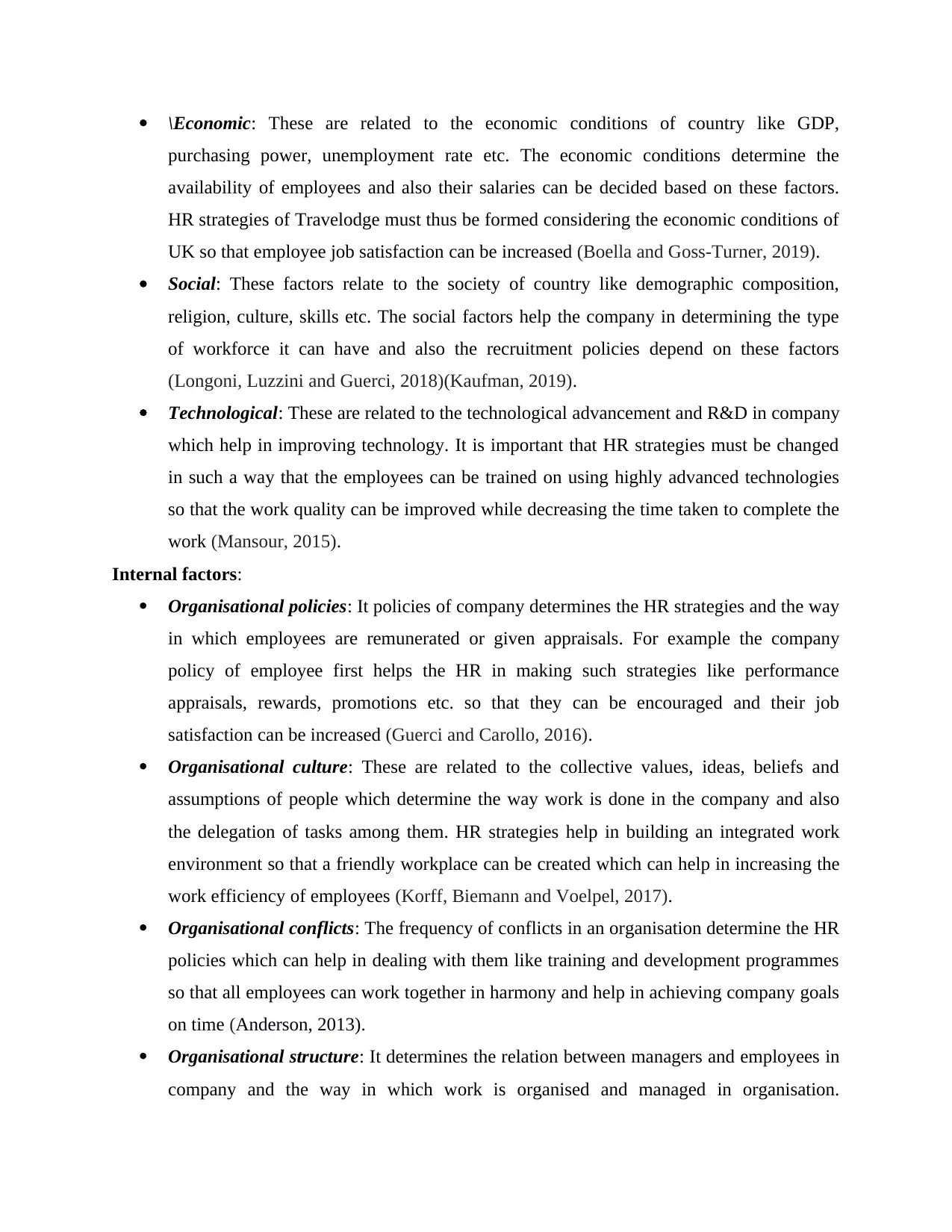
\Economic: These are related to the economic conditions of country like GDP,
purchasing power, unemployment rate etc. The economic conditions determine the
availability of employees and also their salaries can be decided based on these factors.
HR strategies of Travelodge must thus be formed considering the economic conditions of
UK so that employee job satisfaction can be increased (Boella and Goss-Turner, 2019).
Social: These factors relate to the society of country like demographic composition,
religion, culture, skills etc. The social factors help the company in determining the type
of workforce it can have and also the recruitment policies depend on these factors
(Longoni, Luzzini and Guerci, 2018)(Kaufman, 2019).
Technological: These are related to the technological advancement and R&D in company
which help in improving technology. It is important that HR strategies must be changed
in such a way that the employees can be trained on using highly advanced technologies
so that the work quality can be improved while decreasing the time taken to complete the
work (Mansour, 2015).
Internal factors:
Organisational policies: It policies of company determines the HR strategies and the way
in which employees are remunerated or given appraisals. For example the company
policy of employee first helps the HR in making such strategies like performance
appraisals, rewards, promotions etc. so that they can be encouraged and their job
satisfaction can be increased (Guerci and Carollo, 2016).
Organisational culture: These are related to the collective values, ideas, beliefs and
assumptions of people which determine the way work is done in the company and also
the delegation of tasks among them. HR strategies help in building an integrated work
environment so that a friendly workplace can be created which can help in increasing the
work efficiency of employees (Korff, Biemann and Voelpel, 2017).
Organisational conflicts: The frequency of conflicts in an organisation determine the HR
policies which can help in dealing with them like training and development programmes
so that all employees can work together in harmony and help in achieving company goals
on time (Anderson, 2013).
Organisational structure: It determines the relation between managers and employees in
company and the way in which work is organised and managed in organisation.
purchasing power, unemployment rate etc. The economic conditions determine the
availability of employees and also their salaries can be decided based on these factors.
HR strategies of Travelodge must thus be formed considering the economic conditions of
UK so that employee job satisfaction can be increased (Boella and Goss-Turner, 2019).
Social: These factors relate to the society of country like demographic composition,
religion, culture, skills etc. The social factors help the company in determining the type
of workforce it can have and also the recruitment policies depend on these factors
(Longoni, Luzzini and Guerci, 2018)(Kaufman, 2019).
Technological: These are related to the technological advancement and R&D in company
which help in improving technology. It is important that HR strategies must be changed
in such a way that the employees can be trained on using highly advanced technologies
so that the work quality can be improved while decreasing the time taken to complete the
work (Mansour, 2015).
Internal factors:
Organisational policies: It policies of company determines the HR strategies and the way
in which employees are remunerated or given appraisals. For example the company
policy of employee first helps the HR in making such strategies like performance
appraisals, rewards, promotions etc. so that they can be encouraged and their job
satisfaction can be increased (Guerci and Carollo, 2016).
Organisational culture: These are related to the collective values, ideas, beliefs and
assumptions of people which determine the way work is done in the company and also
the delegation of tasks among them. HR strategies help in building an integrated work
environment so that a friendly workplace can be created which can help in increasing the
work efficiency of employees (Korff, Biemann and Voelpel, 2017).
Organisational conflicts: The frequency of conflicts in an organisation determine the HR
policies which can help in dealing with them like training and development programmes
so that all employees can work together in harmony and help in achieving company goals
on time (Anderson, 2013).
Organisational structure: It determines the relation between managers and employees in
company and the way in which work is organised and managed in organisation.

Travelodge follows a flat organisational structure which helps the employees in directly
reporting to the managers which increase the efficiency of decision making and also help
in managing work more efficiently (Boxall, 2018).
Critical analysis of influence of external and contextual development
It can be said that both the internal and external factors create an impact on the hr
strategies of company which must be changed so that the skills and talents of employees can be
developed and used so that organisational goals are efficiently achieved. These factors also help
in developing HR strategies so that the changing customer needs and wants can be efficiently
fulfilled by employees by giving them high quality of goods and services.
Critical evaluation of external factors using models, concepts
It is important that HR strategies are changed with changing external factors so that
employees can be encouraged to perform well by efficiently monitoring and managing their
work. HR Travelodge can use Dave Ulrich HR model which can help the company in
formulation of HR strategies by creating a benchmark so that the HR functions can be efficiently
organised and employees can be motivated to work in a specific direction (Brewster and
Hegewiscs, 2017).
TASK 2
Theories and models which are relevant to strategic HRM
Travelodge can use various theories and models which can help the company in managing,
controlling and directing the work of employees so that they can be encouraged to improve their
performance thereby increasing the productivity of company. These theories can be used by
HRM so that strategies which can help in increasing work efficiency of workers can be
formulated which also help in employee retention in company (Rane, Sunnapwar and Rane,
2016). Following are some such theories which can be applied in Travelodge in the situation
where it is facing a high employee turnover in the company so that these policies can be applied
to formulate effective HR strategies which can help in dealing with the current problems in
company:
Unrealistic theory: This theory states that if a company follows best practices of
managing workers in company then their performance can be maximised. It says that
there is a liner relation between the HR practices and their performance. It also says that
reporting to the managers which increase the efficiency of decision making and also help
in managing work more efficiently (Boxall, 2018).
Critical analysis of influence of external and contextual development
It can be said that both the internal and external factors create an impact on the hr
strategies of company which must be changed so that the skills and talents of employees can be
developed and used so that organisational goals are efficiently achieved. These factors also help
in developing HR strategies so that the changing customer needs and wants can be efficiently
fulfilled by employees by giving them high quality of goods and services.
Critical evaluation of external factors using models, concepts
It is important that HR strategies are changed with changing external factors so that
employees can be encouraged to perform well by efficiently monitoring and managing their
work. HR Travelodge can use Dave Ulrich HR model which can help the company in
formulation of HR strategies by creating a benchmark so that the HR functions can be efficiently
organised and employees can be motivated to work in a specific direction (Brewster and
Hegewiscs, 2017).
TASK 2
Theories and models which are relevant to strategic HRM
Travelodge can use various theories and models which can help the company in managing,
controlling and directing the work of employees so that they can be encouraged to improve their
performance thereby increasing the productivity of company. These theories can be used by
HRM so that strategies which can help in increasing work efficiency of workers can be
formulated which also help in employee retention in company (Rane, Sunnapwar and Rane,
2016). Following are some such theories which can be applied in Travelodge in the situation
where it is facing a high employee turnover in the company so that these policies can be applied
to formulate effective HR strategies which can help in dealing with the current problems in
company:
Unrealistic theory: This theory states that if a company follows best practices of
managing workers in company then their performance can be maximised. It says that
there is a liner relation between the HR practices and their performance. It also says that
⊘ This is a preview!⊘
Do you want full access?
Subscribe today to unlock all pages.

Trusted by 1+ million students worldwide
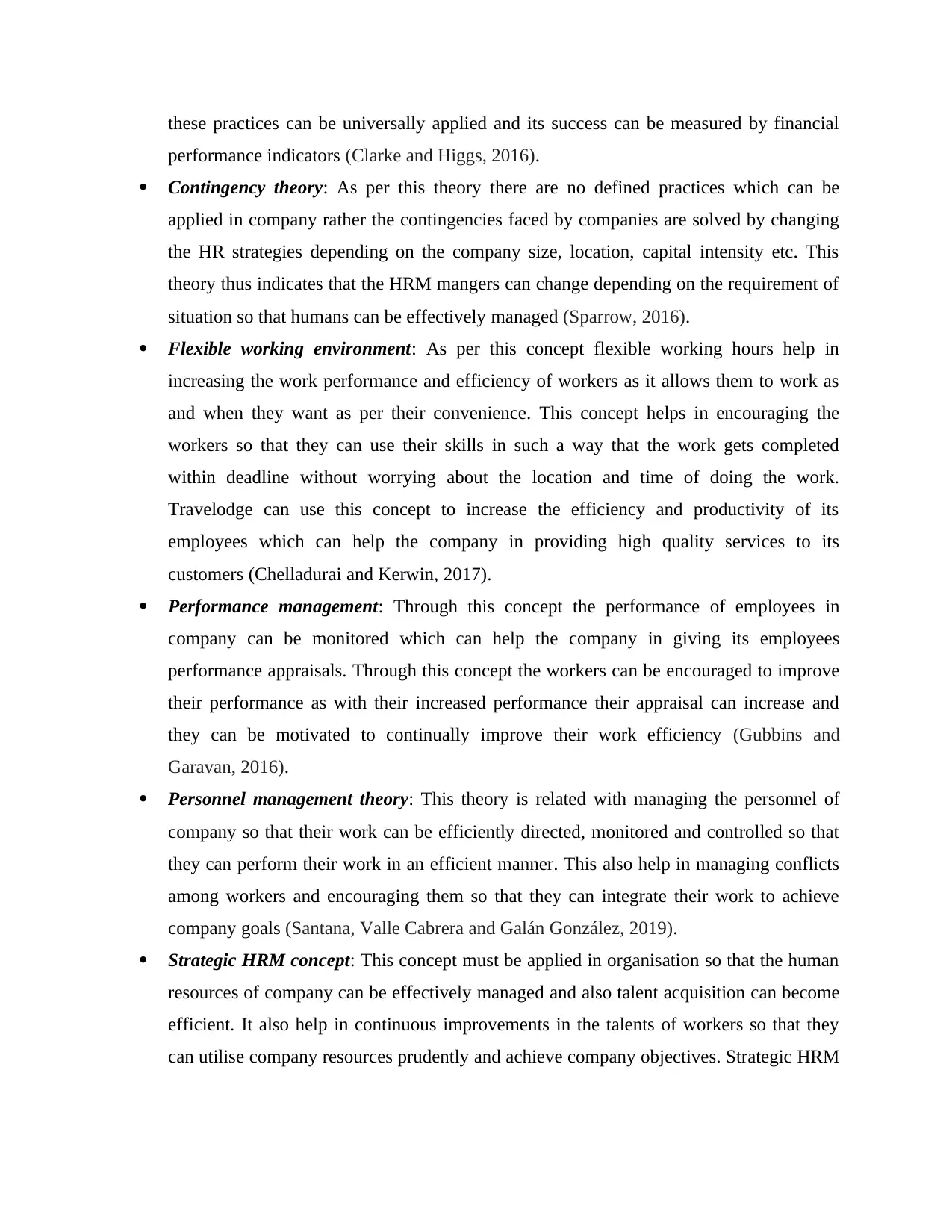
these practices can be universally applied and its success can be measured by financial
performance indicators (Clarke and Higgs, 2016).
Contingency theory: As per this theory there are no defined practices which can be
applied in company rather the contingencies faced by companies are solved by changing
the HR strategies depending on the company size, location, capital intensity etc. This
theory thus indicates that the HRM mangers can change depending on the requirement of
situation so that humans can be effectively managed (Sparrow, 2016).
Flexible working environment: As per this concept flexible working hours help in
increasing the work performance and efficiency of workers as it allows them to work as
and when they want as per their convenience. This concept helps in encouraging the
workers so that they can use their skills in such a way that the work gets completed
within deadline without worrying about the location and time of doing the work.
Travelodge can use this concept to increase the efficiency and productivity of its
employees which can help the company in providing high quality services to its
customers (Chelladurai and Kerwin, 2017).
Performance management: Through this concept the performance of employees in
company can be monitored which can help the company in giving its employees
performance appraisals. Through this concept the workers can be encouraged to improve
their performance as with their increased performance their appraisal can increase and
they can be motivated to continually improve their work efficiency (Gubbins and
Garavan, 2016).
Personnel management theory: This theory is related with managing the personnel of
company so that their work can be efficiently directed, monitored and controlled so that
they can perform their work in an efficient manner. This also help in managing conflicts
among workers and encouraging them so that they can integrate their work to achieve
company goals (Santana, Valle Cabrera and Galán González, 2019).
Strategic HRM concept: This concept must be applied in organisation so that the human
resources of company can be effectively managed and also talent acquisition can become
efficient. It also help in continuous improvements in the talents of workers so that they
can utilise company resources prudently and achieve company objectives. Strategic HRM
performance indicators (Clarke and Higgs, 2016).
Contingency theory: As per this theory there are no defined practices which can be
applied in company rather the contingencies faced by companies are solved by changing
the HR strategies depending on the company size, location, capital intensity etc. This
theory thus indicates that the HRM mangers can change depending on the requirement of
situation so that humans can be effectively managed (Sparrow, 2016).
Flexible working environment: As per this concept flexible working hours help in
increasing the work performance and efficiency of workers as it allows them to work as
and when they want as per their convenience. This concept helps in encouraging the
workers so that they can use their skills in such a way that the work gets completed
within deadline without worrying about the location and time of doing the work.
Travelodge can use this concept to increase the efficiency and productivity of its
employees which can help the company in providing high quality services to its
customers (Chelladurai and Kerwin, 2017).
Performance management: Through this concept the performance of employees in
company can be monitored which can help the company in giving its employees
performance appraisals. Through this concept the workers can be encouraged to improve
their performance as with their increased performance their appraisal can increase and
they can be motivated to continually improve their work efficiency (Gubbins and
Garavan, 2016).
Personnel management theory: This theory is related with managing the personnel of
company so that their work can be efficiently directed, monitored and controlled so that
they can perform their work in an efficient manner. This also help in managing conflicts
among workers and encouraging them so that they can integrate their work to achieve
company goals (Santana, Valle Cabrera and Galán González, 2019).
Strategic HRM concept: This concept must be applied in organisation so that the human
resources of company can be effectively managed and also talent acquisition can become
efficient. It also help in continuous improvements in the talents of workers so that they
can utilise company resources prudently and achieve company objectives. Strategic HRM
Paraphrase This Document
Need a fresh take? Get an instant paraphrase of this document with our AI Paraphraser
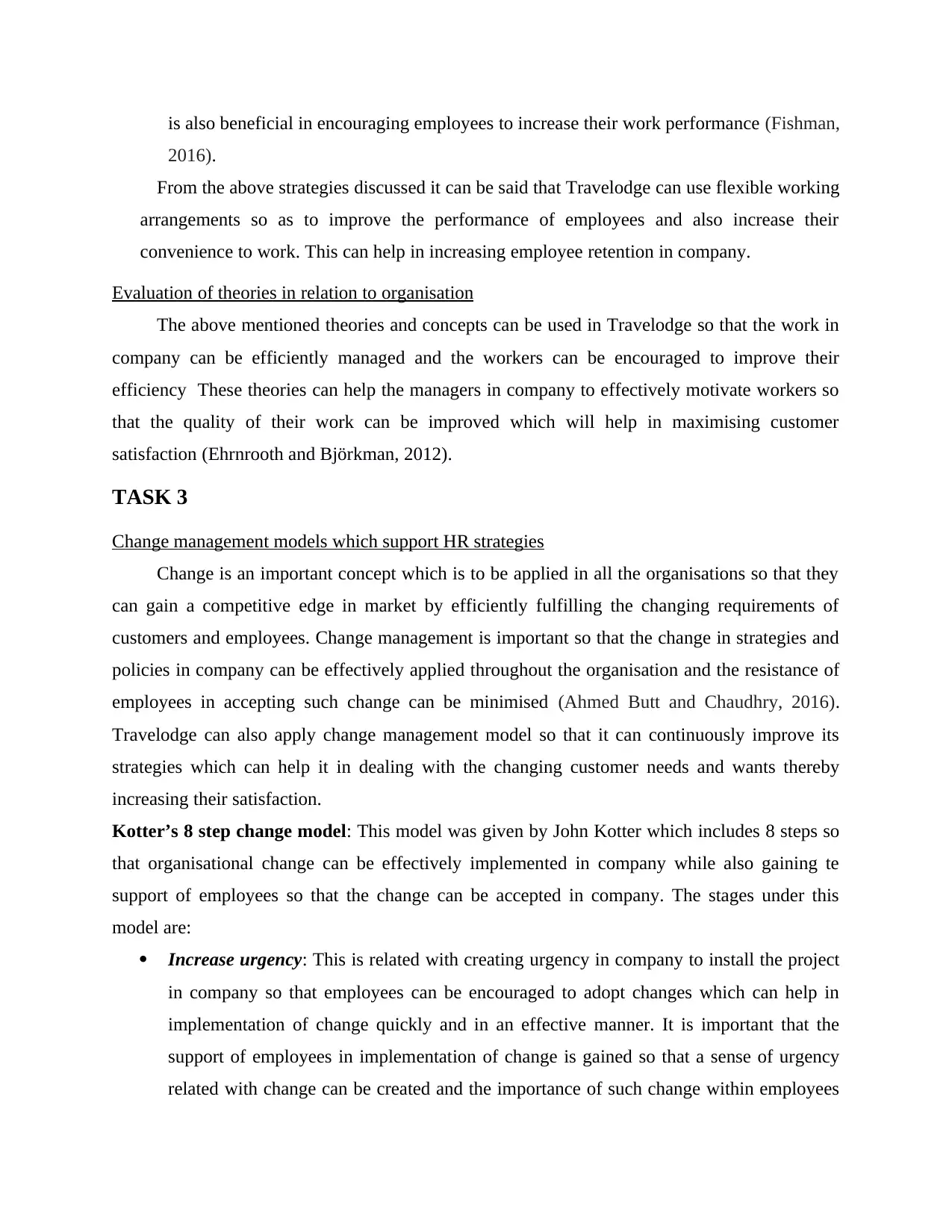
is also beneficial in encouraging employees to increase their work performance (Fishman,
2016).
From the above strategies discussed it can be said that Travelodge can use flexible working
arrangements so as to improve the performance of employees and also increase their
convenience to work. This can help in increasing employee retention in company.
Evaluation of theories in relation to organisation
The above mentioned theories and concepts can be used in Travelodge so that the work in
company can be efficiently managed and the workers can be encouraged to improve their
efficiency These theories can help the managers in company to effectively motivate workers so
that the quality of their work can be improved which will help in maximising customer
satisfaction (Ehrnrooth and Björkman, 2012).
TASK 3
Change management models which support HR strategies
Change is an important concept which is to be applied in all the organisations so that they
can gain a competitive edge in market by efficiently fulfilling the changing requirements of
customers and employees. Change management is important so that the change in strategies and
policies in company can be effectively applied throughout the organisation and the resistance of
employees in accepting such change can be minimised (Ahmed Butt and Chaudhry, 2016).
Travelodge can also apply change management model so that it can continuously improve its
strategies which can help it in dealing with the changing customer needs and wants thereby
increasing their satisfaction.
Kotter’s 8 step change model: This model was given by John Kotter which includes 8 steps so
that organisational change can be effectively implemented in company while also gaining te
support of employees so that the change can be accepted in company. The stages under this
model are:
Increase urgency: This is related with creating urgency in company to install the project
in company so that employees can be encouraged to adopt changes which can help in
implementation of change quickly and in an effective manner. It is important that the
support of employees in implementation of change is gained so that a sense of urgency
related with change can be created and the importance of such change within employees
2016).
From the above strategies discussed it can be said that Travelodge can use flexible working
arrangements so as to improve the performance of employees and also increase their
convenience to work. This can help in increasing employee retention in company.
Evaluation of theories in relation to organisation
The above mentioned theories and concepts can be used in Travelodge so that the work in
company can be efficiently managed and the workers can be encouraged to improve their
efficiency These theories can help the managers in company to effectively motivate workers so
that the quality of their work can be improved which will help in maximising customer
satisfaction (Ehrnrooth and Björkman, 2012).
TASK 3
Change management models which support HR strategies
Change is an important concept which is to be applied in all the organisations so that they
can gain a competitive edge in market by efficiently fulfilling the changing requirements of
customers and employees. Change management is important so that the change in strategies and
policies in company can be effectively applied throughout the organisation and the resistance of
employees in accepting such change can be minimised (Ahmed Butt and Chaudhry, 2016).
Travelodge can also apply change management model so that it can continuously improve its
strategies which can help it in dealing with the changing customer needs and wants thereby
increasing their satisfaction.
Kotter’s 8 step change model: This model was given by John Kotter which includes 8 steps so
that organisational change can be effectively implemented in company while also gaining te
support of employees so that the change can be accepted in company. The stages under this
model are:
Increase urgency: This is related with creating urgency in company to install the project
in company so that employees can be encouraged to adopt changes which can help in
implementation of change quickly and in an effective manner. It is important that the
support of employees in implementation of change is gained so that a sense of urgency
related with change can be created and the importance of such change within employees
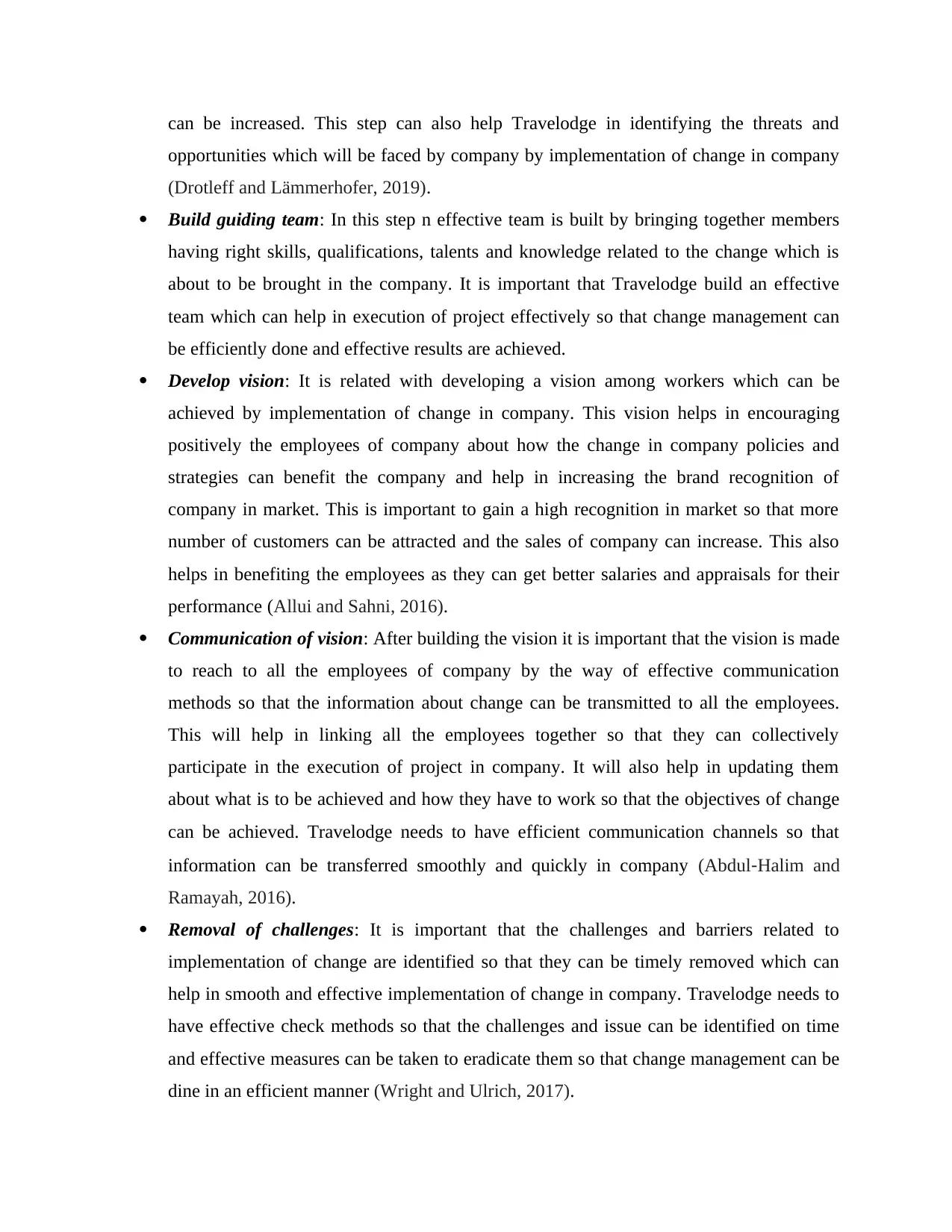
can be increased. This step can also help Travelodge in identifying the threats and
opportunities which will be faced by company by implementation of change in company
(Drotleff and Lämmerhofer, 2019) .
Build guiding team: In this step n effective team is built by bringing together members
having right skills, qualifications, talents and knowledge related to the change which is
about to be brought in the company. It is important that Travelodge build an effective
team which can help in execution of project effectively so that change management can
be efficiently done and effective results are achieved.
Develop vision: It is related with developing a vision among workers which can be
achieved by implementation of change in company. This vision helps in encouraging
positively the employees of company about how the change in company policies and
strategies can benefit the company and help in increasing the brand recognition of
company in market. This is important to gain a high recognition in market so that more
number of customers can be attracted and the sales of company can increase. This also
helps in benefiting the employees as they can get better salaries and appraisals for their
performance (Allui and Sahni, 2016).
Communication of vision: After building the vision it is important that the vision is made
to reach to all the employees of company by the way of effective communication
methods so that the information about change can be transmitted to all the employees.
This will help in linking all the employees together so that they can collectively
participate in the execution of project in company. It will also help in updating them
about what is to be achieved and how they have to work so that the objectives of change
can be achieved. Travelodge needs to have efficient communication channels so that
information can be transferred smoothly and quickly in company (Abdul‐Halim and
Ramayah, 2016).
Removal of challenges: It is important that the challenges and barriers related to
implementation of change are identified so that they can be timely removed which can
help in smooth and effective implementation of change in company. Travelodge needs to
have effective check methods so that the challenges and issue can be identified on time
and effective measures can be taken to eradicate them so that change management can be
dine in an efficient manner (Wright and Ulrich, 2017).
opportunities which will be faced by company by implementation of change in company
(Drotleff and Lämmerhofer, 2019) .
Build guiding team: In this step n effective team is built by bringing together members
having right skills, qualifications, talents and knowledge related to the change which is
about to be brought in the company. It is important that Travelodge build an effective
team which can help in execution of project effectively so that change management can
be efficiently done and effective results are achieved.
Develop vision: It is related with developing a vision among workers which can be
achieved by implementation of change in company. This vision helps in encouraging
positively the employees of company about how the change in company policies and
strategies can benefit the company and help in increasing the brand recognition of
company in market. This is important to gain a high recognition in market so that more
number of customers can be attracted and the sales of company can increase. This also
helps in benefiting the employees as they can get better salaries and appraisals for their
performance (Allui and Sahni, 2016).
Communication of vision: After building the vision it is important that the vision is made
to reach to all the employees of company by the way of effective communication
methods so that the information about change can be transmitted to all the employees.
This will help in linking all the employees together so that they can collectively
participate in the execution of project in company. It will also help in updating them
about what is to be achieved and how they have to work so that the objectives of change
can be achieved. Travelodge needs to have efficient communication channels so that
information can be transferred smoothly and quickly in company (Abdul‐Halim and
Ramayah, 2016).
Removal of challenges: It is important that the challenges and barriers related to
implementation of change are identified so that they can be timely removed which can
help in smooth and effective implementation of change in company. Travelodge needs to
have effective check methods so that the challenges and issue can be identified on time
and effective measures can be taken to eradicate them so that change management can be
dine in an efficient manner (Wright and Ulrich, 2017).
⊘ This is a preview!⊘
Do you want full access?
Subscribe today to unlock all pages.

Trusted by 1+ million students worldwide

Create short term wins: During the implementation of change it is important that short
term goals are set so that the project can become easy and simple to execute With the
gaining of each short term goal the employees can be motivated to move towards
achieving the long-term aim of the project. This can help in gaining the objectives of
change management and increasing the benefits for company through this project.
Don’t let up: This step means that the team members must not give up on the plan
execution and continually move towards the complete execution of plan. This step is also
important as it will help in making the project more valuable and will motivate the
employees in taking the project more seriously so that it can be efficiently implemented
in company (Mahmood and Hyatt, 2019).
Make change stick: It means that the change which is implemented in company must not
be changed quickly and should be effective in company over a long duration of time. This
can help the company in saving the costs of frequent change implementation which can
also discourage the employees and they can take the project in a non-serious manner.
Nudge theory: This theory relates to the behavioural science which means that positive
behaviour towards the employees can help in encouraging them to accept changes in a positive
manner. This theory states that with the increase in positive behaviour the goals and objectives of
change in company can be efficiently achieved. Performance appraisals, rewards etc. can help in
generating a positive behaviour of employees towards the change so that they can efficiently
accept change (Paauwe and Boon, 2018).
TASK 4
Monitoring and measuring HR outcomes
The outcomes of HR can be measured by determining the increased level of work
performance and efficiency of workers so that they can perform their work in an efficient manner
within a certain time limit and by using resources in an efficient manner. The increased friendly
work environment in company, reduced conflicts among workers, increased willingness of
workers to improve their work and to learn new things determine the level of effectiveness of HR
strategies in company. The HR strategies of company can help the company in achieving its
goals within a stipulated time and budget so that the cost of company can be regulated and
managed while increasing the profitability of company. Travelodge can measure the
term goals are set so that the project can become easy and simple to execute With the
gaining of each short term goal the employees can be motivated to move towards
achieving the long-term aim of the project. This can help in gaining the objectives of
change management and increasing the benefits for company through this project.
Don’t let up: This step means that the team members must not give up on the plan
execution and continually move towards the complete execution of plan. This step is also
important as it will help in making the project more valuable and will motivate the
employees in taking the project more seriously so that it can be efficiently implemented
in company (Mahmood and Hyatt, 2019).
Make change stick: It means that the change which is implemented in company must not
be changed quickly and should be effective in company over a long duration of time. This
can help the company in saving the costs of frequent change implementation which can
also discourage the employees and they can take the project in a non-serious manner.
Nudge theory: This theory relates to the behavioural science which means that positive
behaviour towards the employees can help in encouraging them to accept changes in a positive
manner. This theory states that with the increase in positive behaviour the goals and objectives of
change in company can be efficiently achieved. Performance appraisals, rewards etc. can help in
generating a positive behaviour of employees towards the change so that they can efficiently
accept change (Paauwe and Boon, 2018).
TASK 4
Monitoring and measuring HR outcomes
The outcomes of HR can be measured by determining the increased level of work
performance and efficiency of workers so that they can perform their work in an efficient manner
within a certain time limit and by using resources in an efficient manner. The increased friendly
work environment in company, reduced conflicts among workers, increased willingness of
workers to improve their work and to learn new things determine the level of effectiveness of HR
strategies in company. The HR strategies of company can help the company in achieving its
goals within a stipulated time and budget so that the cost of company can be regulated and
managed while increasing the profitability of company. Travelodge can measure the
Paraphrase This Document
Need a fresh take? Get an instant paraphrase of this document with our AI Paraphraser
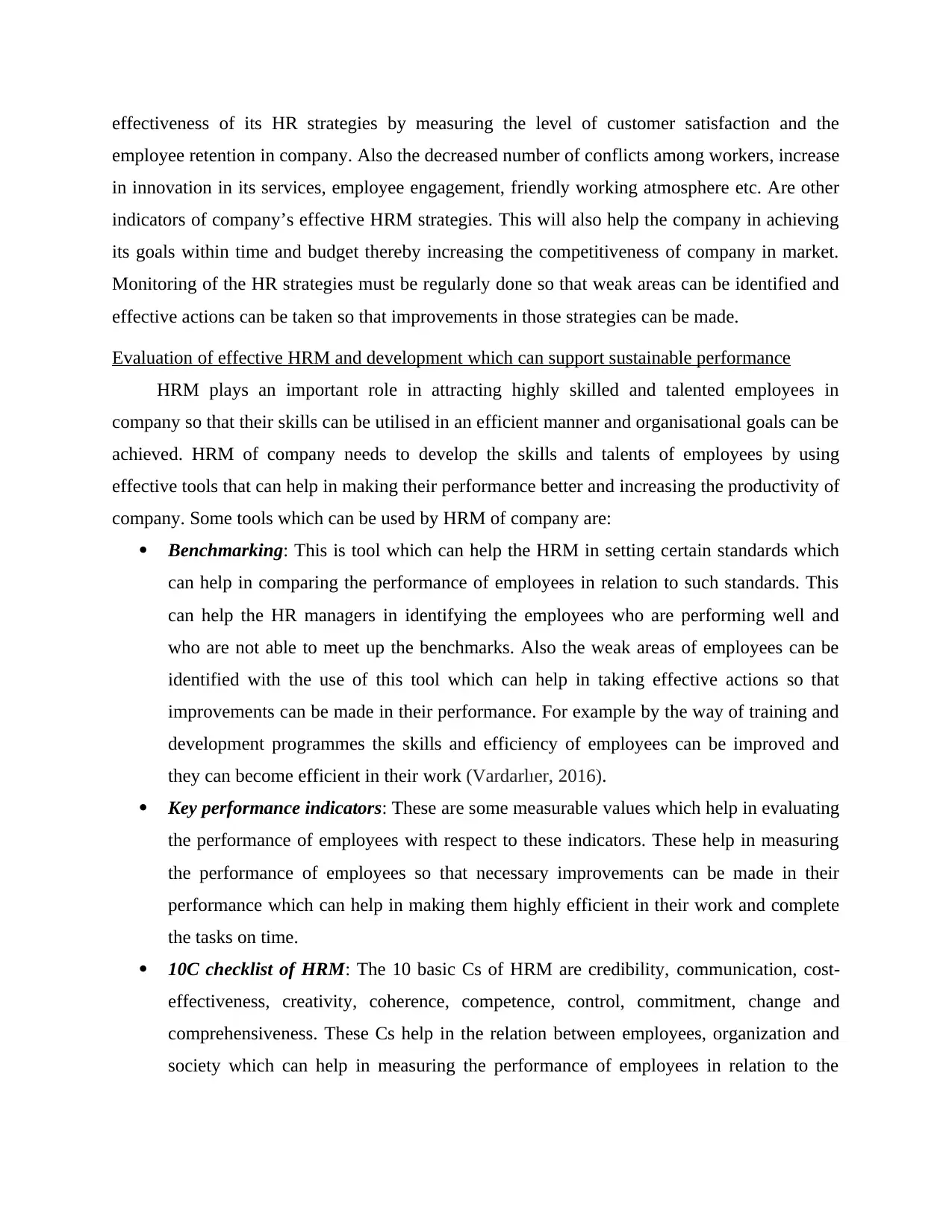
effectiveness of its HR strategies by measuring the level of customer satisfaction and the
employee retention in company. Also the decreased number of conflicts among workers, increase
in innovation in its services, employee engagement, friendly working atmosphere etc. Are other
indicators of company’s effective HRM strategies. This will also help the company in achieving
its goals within time and budget thereby increasing the competitiveness of company in market.
Monitoring of the HR strategies must be regularly done so that weak areas can be identified and
effective actions can be taken so that improvements in those strategies can be made.
Evaluation of effective HRM and development which can support sustainable performance
HRM plays an important role in attracting highly skilled and talented employees in
company so that their skills can be utilised in an efficient manner and organisational goals can be
achieved. HRM of company needs to develop the skills and talents of employees by using
effective tools that can help in making their performance better and increasing the productivity of
company. Some tools which can be used by HRM of company are:
Benchmarking: This is tool which can help the HRM in setting certain standards which
can help in comparing the performance of employees in relation to such standards. This
can help the HR managers in identifying the employees who are performing well and
who are not able to meet up the benchmarks. Also the weak areas of employees can be
identified with the use of this tool which can help in taking effective actions so that
improvements can be made in their performance. For example by the way of training and
development programmes the skills and efficiency of employees can be improved and
they can become efficient in their work (Vardarlıer, 2016).
Key performance indicators: These are some measurable values which help in evaluating
the performance of employees with respect to these indicators. These help in measuring
the performance of employees so that necessary improvements can be made in their
performance which can help in making them highly efficient in their work and complete
the tasks on time.
10C checklist of HRM: The 10 basic Cs of HRM are credibility, communication, cost-
effectiveness, creativity, coherence, competence, control, commitment, change and
comprehensiveness. These Cs help in the relation between employees, organization and
society which can help in measuring the performance of employees in relation to the
employee retention in company. Also the decreased number of conflicts among workers, increase
in innovation in its services, employee engagement, friendly working atmosphere etc. Are other
indicators of company’s effective HRM strategies. This will also help the company in achieving
its goals within time and budget thereby increasing the competitiveness of company in market.
Monitoring of the HR strategies must be regularly done so that weak areas can be identified and
effective actions can be taken so that improvements in those strategies can be made.
Evaluation of effective HRM and development which can support sustainable performance
HRM plays an important role in attracting highly skilled and talented employees in
company so that their skills can be utilised in an efficient manner and organisational goals can be
achieved. HRM of company needs to develop the skills and talents of employees by using
effective tools that can help in making their performance better and increasing the productivity of
company. Some tools which can be used by HRM of company are:
Benchmarking: This is tool which can help the HRM in setting certain standards which
can help in comparing the performance of employees in relation to such standards. This
can help the HR managers in identifying the employees who are performing well and
who are not able to meet up the benchmarks. Also the weak areas of employees can be
identified with the use of this tool which can help in taking effective actions so that
improvements can be made in their performance. For example by the way of training and
development programmes the skills and efficiency of employees can be improved and
they can become efficient in their work (Vardarlıer, 2016).
Key performance indicators: These are some measurable values which help in evaluating
the performance of employees with respect to these indicators. These help in measuring
the performance of employees so that necessary improvements can be made in their
performance which can help in making them highly efficient in their work and complete
the tasks on time.
10C checklist of HRM: The 10 basic Cs of HRM are credibility, communication, cost-
effectiveness, creativity, coherence, competence, control, commitment, change and
comprehensiveness. These Cs help in the relation between employees, organization and
society which can help in measuring the performance of employees in relation to the
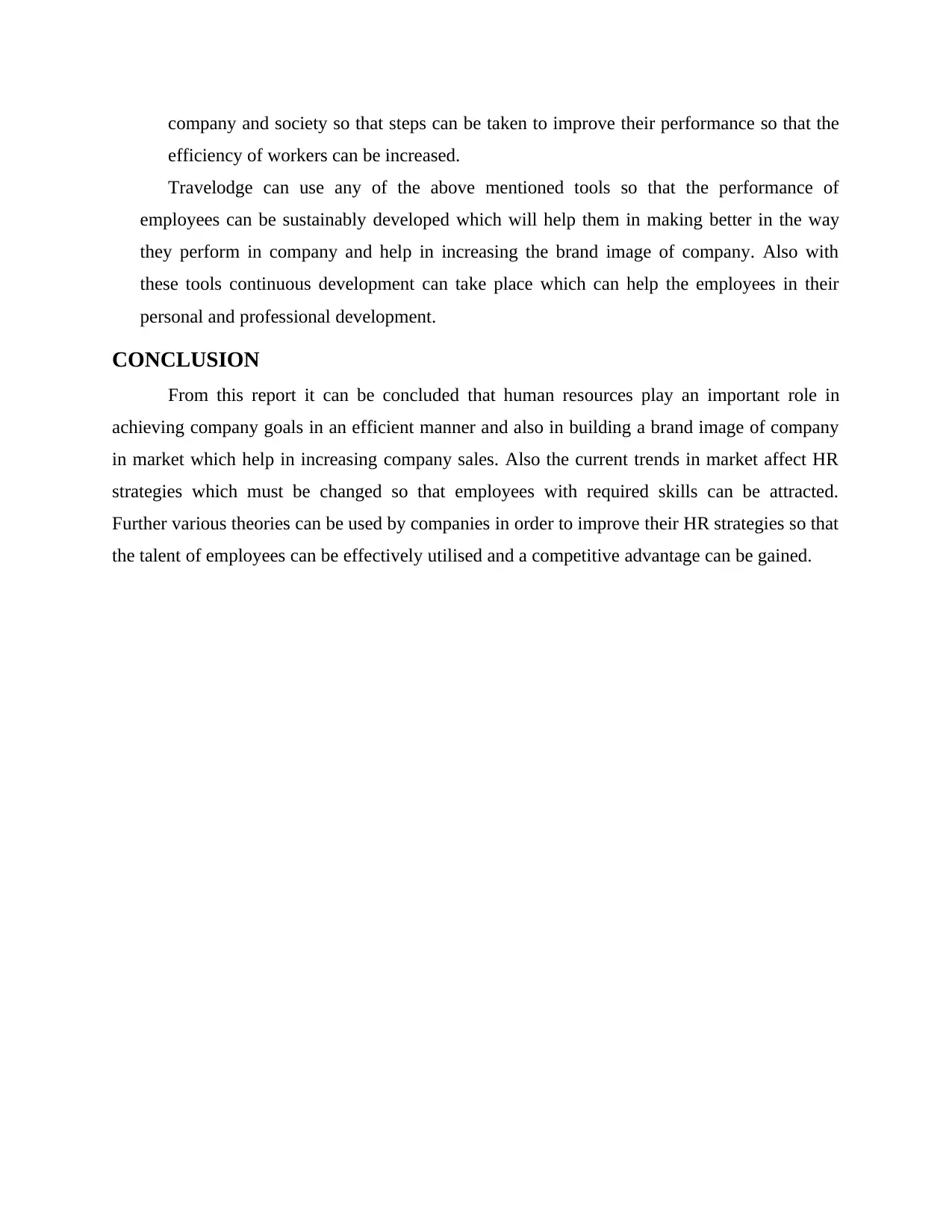
company and society so that steps can be taken to improve their performance so that the
efficiency of workers can be increased.
Travelodge can use any of the above mentioned tools so that the performance of
employees can be sustainably developed which will help them in making better in the way
they perform in company and help in increasing the brand image of company. Also with
these tools continuous development can take place which can help the employees in their
personal and professional development.
CONCLUSION
From this report it can be concluded that human resources play an important role in
achieving company goals in an efficient manner and also in building a brand image of company
in market which help in increasing company sales. Also the current trends in market affect HR
strategies which must be changed so that employees with required skills can be attracted.
Further various theories can be used by companies in order to improve their HR strategies so that
the talent of employees can be effectively utilised and a competitive advantage can be gained.
efficiency of workers can be increased.
Travelodge can use any of the above mentioned tools so that the performance of
employees can be sustainably developed which will help them in making better in the way
they perform in company and help in increasing the brand image of company. Also with
these tools continuous development can take place which can help the employees in their
personal and professional development.
CONCLUSION
From this report it can be concluded that human resources play an important role in
achieving company goals in an efficient manner and also in building a brand image of company
in market which help in increasing company sales. Also the current trends in market affect HR
strategies which must be changed so that employees with required skills can be attracted.
Further various theories can be used by companies in order to improve their HR strategies so that
the talent of employees can be effectively utilised and a competitive advantage can be gained.
⊘ This is a preview!⊘
Do you want full access?
Subscribe today to unlock all pages.

Trusted by 1+ million students worldwide
1 out of 14
Related Documents
Your All-in-One AI-Powered Toolkit for Academic Success.
+13062052269
info@desklib.com
Available 24*7 on WhatsApp / Email
![[object Object]](/_next/static/media/star-bottom.7253800d.svg)
Unlock your academic potential
Copyright © 2020–2025 A2Z Services. All Rights Reserved. Developed and managed by ZUCOL.





